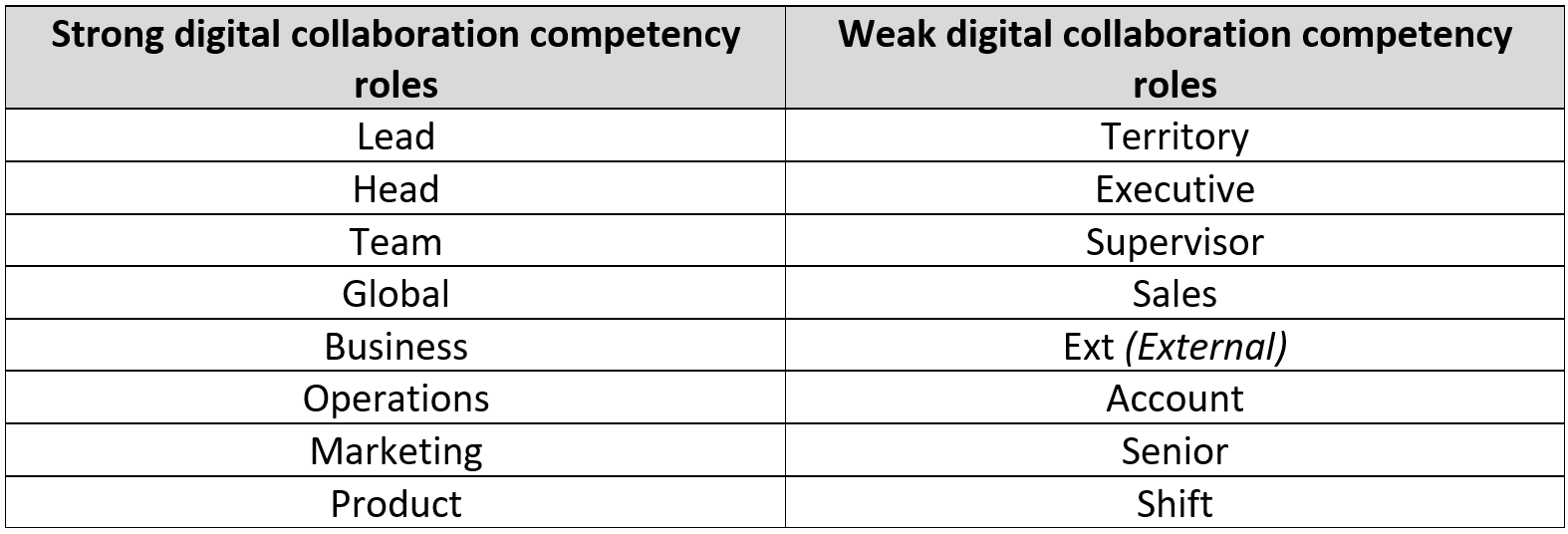All leaders aren’t equal when it comes to digital collaboration competencies
A key insight from SWOOP Analytics’ recent M365 Benchmarking Study is that, on average, leaders were found to practice higher levels of digital collaboration competency than non-leaders. This result was against expectations. In discussing this result with our study audiences, several mentioned, with a degree of levity, their own managers would be in the “below average” cohort.
Our response has been that another key finding in the report was the huge variation in digital collaboration habits found; and that of course the leaders were also not immune to such variation.
That said, in this blog post we dig a little deeper to explore just what leadership job roles are likely to be associated with strong digital collaboration capabilities; and those at the other end of the scale, with poor digital collaboration capabilities.
Review of the leaders’ collaboration assessment
In the M365 Benchmarking report we described our methodology as:
From our benchmarking participants, we identified almost 50,000 individuals with a job role title. We excluded any individuals with no active participation over the six-month period. We selected a “leaders” grouping based on their job title. The key words we chose for their selection included:
“Leader”,”Supervisor”,”Manager”,”Managing”,”Lead”,”Partner”,”Principal”,”Director”,”Executive” and ”Head”.
Some 12,613 staff were classified as “leaders”.
Identifying leaders and laggards
From this list of 12,613 leaders, we extracted a list of the job titles that achieved a SWOOP Collaboration Habits score of 80 or more (maximum = 100). We identified 4,269 leaders who we labelled the “Leading Leaders”. We then identified those leaders that had scored below 20 (minimum = 0), labelling them “Laggard Leaders”. This was a much smaller but still significant list, with 793 members.
We then took the job titles from the respective lists and fed them into word cloud software with the following results:
In interpreting these word clouds, terms that are largely unique to a single word cloud are reflective of the role’s digital collaboration competency profile.
We can see the term “Manager” is generic and appears as the top term in both word clouds i.e. it offers no distinguishing insight. The term “Lead” appears prominent in both clouds, but when the actual word weightings are compared, the term is significantly more prominent in the “leaders” word cloud than the “laggards” word cloud.
The following roles do appear to be associated with strong and weak digital collaboration habits (using actual word relative weightings):
What can we learn from this?
Weak digital collaboration roles
If we look firstly at the weaker collaboration roles, there are two themes:
Selling related (sales/account/ext/territory)
It’s likely sales or customer facing staff are overly reliant on email for connecting with their clients. Much of their digital work may also be conducted in non-M365 software e.g. Salesforce, Dynamics. On the darker side, for many organisations, sales staff have particular personal incentives that can work against collaborative work.
We would argue that it doesn’t have to be like that. Our M365 Benchmarking report showcases two case studies from digital consulting firm Engaged Squared and real estate consultancy Real Foundations where clients and partners are actively encouraged to participate in M365 shared digital spaces, with exceptional results.
Ultimately, it’s more about changing the nature of the relationship with external stakeholders to be more intensely collaborative; with the technology there now to help facilitate this.
2. “Minder” type roles (supervisor/senior/shift) and executive
When we talk about “Minder” roles we are typically referring to middle line management staff. They have become the link between frontline staff and senior leadership. How a line manager perceives their role can have a huge difference in how they choose to communicate digitally. A traditional “manager” might favour more formal lines of digital communication i.e. email. Whereas more enlightened “leaders” would engage more actively as a team/group coach. In this case, the digital communication modes would be less formal and more interactive i.e. making use of Microsoft Teams channels, chat and Yammer.
The “Executive” role infers top of the hierarchy positions. The pandemic has taught us that senior executives can gain more active engagement with staff using enterprise social networking (ESN) platforms like Yammer and Workplace by Meta. This data suggests that many executives may still be using group emails for one-way group wide communications.
Changing the digital communication habits of those in the above roles is going to take more than just end-user training in the tools. In the same way we have seen senior leaders “coached” into how to communicate and engage with staff using ESN platforms, sales and other externally facing staff have to be coached into more effective ways of engaging with their external stakeholders. The pandemic has levelled the playing field both within and between organisations. Line managers, in particular, will now need to re-think how their roles need to change in a hybrid or remote working world, if they are to remain relevant.
Strong digital collaboration roles – what’s in a name?
So what roles can leaders look to, to provide the best examples of digital collaboration habits? It might seem speculative, but it does sound that the way a role is labelled does reflect how that role is being undertaken. For example:
Lead vs Supervisor
Head vs Executive
Global vs Territory
Team vs Account
Marketing vs Sales
The terms on the left belong to the strong digital collaboration cohort, the right to the weak cohort. Terms like “marketing”, “business”, “operations” and “product” are expansionary, requiring collaboration. Terms like “Territory”, “Account”, “Shift” infer exclusiveness and potential silos. One might also argue the role names on the left are more modern and enlightened; while those on the right are more traditional and arguably now old fashioned?
It should be noted that role titles on both the left and right co-exist inside the same organisations. As we highlighted in our M365 benchmarking study, digital collaboration competencies vary wildly across organisations. If you are a leader struggling with digital collaboration, and your job title reflects this negative association; why not seek out some of your colleagues that occupy the more enlightened job roles, for assistance.




